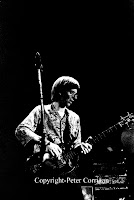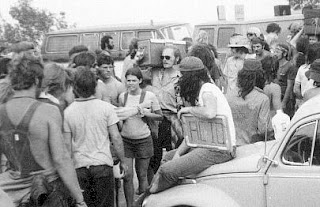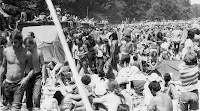Thursday, March 18, 1971
Fox Theatre, St. Louis, MO
Soundboard Recording
Time for another thoroughly rewarding journey into a thoroughly forgotten corner of the Grateful Dead’s concert history. Pretty much the last month one thinks about when contemplating 1971 is March of that year. Bookended on one side by the infamous February ’71 shows where Mickey left the band and what seems like 50 new songs were introduced, and on the other with the historic month of April ending with the closing of the Fillmore East run, March has had almost everything going against it, not the least of which was the number of dates that simply didn’t circulate at all from this month, for nearly ever. 1971 also tends to end up near the bottom of the list when folks stack all the 70’s against each other, right there next to the woefully disrespected 1976. So, shows from this year can often gather dust.
I remember hooking up with this great older deadhead trader years ago who turned me on to many wonderful shows. In one of our trades he included a complete 03/18/71 which was so under-circulating at the time, I assumed it might have to be mislabeled because there was simply no information on this show anywhere I looked. Even to this day, many online information archives (http://www.deadbase.com/, http://www.deadlists.com/) still do not list all the accurate information about this particular date. As it turned out, I had come into possession of a 1971 show that redefined nearly everything I thought I knew about the year. You see, I fell prey to the not too uncommon sentiment about 1971: it isn’t 1970, and it sure as hell isn’t 1972. So it got overlooked and undervalued.
 Well, because this pigeonholing is in large part unfair, it makes for fertile ground in finding great music to listen to and recommend. March 18th, 1971 at the Fox Theatre in St. Louis, MO intensifies this tendency because it is so completely unthought-of. Well, no more my dear friends. Cue it up. Turn it up. Open up. This show has both the fully satisfying highlights you would expect at first glance, and a number of highlights you might not expect.
Well, because this pigeonholing is in large part unfair, it makes for fertile ground in finding great music to listen to and recommend. March 18th, 1971 at the Fox Theatre in St. Louis, MO intensifies this tendency because it is so completely unthought-of. Well, no more my dear friends. Cue it up. Turn it up. Open up. This show has both the fully satisfying highlights you would expect at first glance, and a number of highlights you might not expect.Sound quality of soundboards seemed to go up a notch with Mickey’s departure. Clearly a lot of mics and mixing space freed up for Bear with the exit of an entire drum set. That, and here 28 days after Mickey’s last show, the band had comfortably found ways to fill in the gaps. Billy, being the amazing talent that he is, probably had the least trouble adjusting. All that said, it is really cool to hear the new cadence given to all the music now that they were back to the original Warlocks lineup. On both the old and new songs, the band seemed to take this roster adjustment in complete stride and come out on the other side all the better for it. This tape sounds fantastic. Also worth noting for the guitar gear enthusiasts out there, this show appears within a small stretch of time during which Jerry was playing a custom built guitar (very likely from the folks at Alembic), and while he didn’t stick with it long at all, this guitar sounds very very very good. Wowie wow wow. You can’t miss it. This guitar is seen in the photos featured with this post.
When it comes to this show in particular, all of that is just the background. 03/18/71 is an absolute rocket ship (especially set two). The energy beaming out of the band on this night leaps off the tape. The stories of how Bear would be brewing up his electric Kool-Aid (typically orange, and set about a theatre in large containers for casual consumption) run rampant well into the 70’s decade, and the band and crowd seem to be completely flying as this show moves along, captured on tape not only in the music, but in the energy of the often ample between song banter going on between everyone. By set two, this show just resonates with that “vibe.”
 Set one is the epitome of “good old Grateful Dead.” The band is relaxed, in the groove, somewhat cocky, and completely enjoying themselves. The tape picks up moments after the start of Casey Jones, and we swing through a great set of tunes. Everyone is getting comfortable. By the time we reach China Cat Sunflower, the band is tuned in nicely. Jerry’s guitar is sounding gorgeous. Bobby takes a really nice solo on the way down the road to I Know You Rider, with Jerry demonstrating for us how, beyond being able to stop the world with his lead guitar playing, he was also a most consummate rhythm player. From the sound of it, he’s very much enjoying the feel of this new axe. There’s a reel flip that isn’t too painful (not the last one we’ll encounter on this night), but other than that, this is some wonderful stuff. Phil, Jerry, and Bobby harmonizing with Billy shuffling along the beat, and Garcia’s mellow lead lines filling the gaps between words is sweetly satisfying. The set ends prematurely when a string is broken in Cumberland Blues and Jerry suggests that they take a ten minute break.
Set one is the epitome of “good old Grateful Dead.” The band is relaxed, in the groove, somewhat cocky, and completely enjoying themselves. The tape picks up moments after the start of Casey Jones, and we swing through a great set of tunes. Everyone is getting comfortable. By the time we reach China Cat Sunflower, the band is tuned in nicely. Jerry’s guitar is sounding gorgeous. Bobby takes a really nice solo on the way down the road to I Know You Rider, with Jerry demonstrating for us how, beyond being able to stop the world with his lead guitar playing, he was also a most consummate rhythm player. From the sound of it, he’s very much enjoying the feel of this new axe. There’s a reel flip that isn’t too painful (not the last one we’ll encounter on this night), but other than that, this is some wonderful stuff. Phil, Jerry, and Bobby harmonizing with Billy shuffling along the beat, and Garcia’s mellow lead lines filling the gaps between words is sweetly satisfying. The set ends prematurely when a string is broken in Cumberland Blues and Jerry suggests that they take a ten minute break.As if to repent for cutting the first set off at the knees, the band opens set two with a great jam of Truckin’ > Drums > Other One > Wharf Rat. You can feel how much the energy is bursting forth while listening to Jerry’s boulder crushing power chords out of the “Get back truckin’ on!” section. It’s one of those moments so intense that you must pause and take notice, smiling and shaking your head a little. Wow, Jerry. Feeling it much?
Other One hints appear and usher in Billy’s drum solo, and then the band returns to mount an intense, spidery, and darkly emotional Other One that seems to explore an old abandoned mansion full of dark and dusty rooms. Directions change, vision blurs, and all the while, Garcia’s tone burns with his hallmarked yearning and crooning intensity that so typified Other Ones from '71. The Wharf Rat that follows is still young and finding its legs. For me, what follows all of this is some of the most enjoyable music of the year.
 You will be making a monstrous mistake if you pass on listening to the next three songs all the way through. Sugar Magnolia gets started amidst Bobby being teased by the rest of the band, in a wonderful humorous mood (Jerry scolds him for going too fast while someone else tells him to go faster, and then someone is impersonating the girls who call out his name from the crowd. Bobby can even be heard telling the band to shut up). The song is then absolutely nailed. With Jerry’s wha-wha on the entire time, the song demonstrates this new found psychedelic foothold the band had reached in its rock-folk leanings born over the last year or so. Again, the energy pours out of the music more powerfully than one might expect. And a special nod needs to go to Jerry’s backing vocals. His treatments are really nice.
You will be making a monstrous mistake if you pass on listening to the next three songs all the way through. Sugar Magnolia gets started amidst Bobby being teased by the rest of the band, in a wonderful humorous mood (Jerry scolds him for going too fast while someone else tells him to go faster, and then someone is impersonating the girls who call out his name from the crowd. Bobby can even be heard telling the band to shut up). The song is then absolutely nailed. With Jerry’s wha-wha on the entire time, the song demonstrates this new found psychedelic foothold the band had reached in its rock-folk leanings born over the last year or so. Again, the energy pours out of the music more powerfully than one might expect. And a special nod needs to go to Jerry’s backing vocals. His treatments are really nice.As if to outdo what is already shaping up into more than just your average Dead show, the band decides to do a song pairing next (after minutes of debate, and the crowd egging them on) of the then very new Greatest Story Ever Told > Johnny B Goode. Greatest Story is awash with more wonderful wha-wha work from Garcia. The song boils over with psychedelic over and under tones. The music throbs with this power, and you can feel it breathe and pulse in front of you. When they quite nearly explode into Johnny B Goode as if the two songs have been joined together since birth, you can’t help but be completely laid out by the intensity. Fire leaps off the music.
Another broken string inserts a brief pause before we head down the home stretch. While it doesn’t take any extreme chances in exploring alternate themes, Not Fade Away is a textbook version, and it leads the way into the same beautifully bubbling rocking-along shuffle found earlier in I Know You Rider as it rides the transition into Goin’ Down The Road Feelin’ Bad. This tune was a new addition only six months earlier (discussed in the review of 10/23/70), yet by now they had fully baked it into the rotation, and it exemplified the maturity of this entire push the band made into their folk/acoustic leanings. This is pure Grateful Dead-ness from 1971, and it can warm the blood in your veins with its easy going nature. Once again, the band is finding ways to rewrite the rules of what could be psychedelic music. A brutal reel flip wipes out what might have been a large portion of music, returning as the band is headed into the final sections of the song. But fear not, we have the rest of the show preserved nicely.
 Instead of headed back to Not Fade Away, Jerry queues up Caution (its only appearance in 1971), and the rest of the band latches on. Pigpen pulls out his harmonica and the band is fused into one of their most wonderful thematic undercurrents of all – where Bluegrass meets Viola Lee Blues, Caution, and Cumberland Blues. It’s a swaggering bluesy journey, and Pigpen proves yet again that he’s not quite made for the politically correct world of today. Under his storytelling, the band turns like a ball of fire. The music ever so slowly dismantles itself further and further into a sea of chaos which eventually tips over the edge into Feedback.
Instead of headed back to Not Fade Away, Jerry queues up Caution (its only appearance in 1971), and the rest of the band latches on. Pigpen pulls out his harmonica and the band is fused into one of their most wonderful thematic undercurrents of all – where Bluegrass meets Viola Lee Blues, Caution, and Cumberland Blues. It’s a swaggering bluesy journey, and Pigpen proves yet again that he’s not quite made for the politically correct world of today. Under his storytelling, the band turns like a ball of fire. The music ever so slowly dismantles itself further and further into a sea of chaos which eventually tips over the edge into Feedback.Not only is this the only occurrence of primal Feedback in 1971, this would actually be the very last time Feedback showed up like this in a set list at all. Given a fitting send off, the world spirals out of anything remotely recognizable into a deeper layer of reality spun by cavernous moans and shattering starlight. In many ways the Dead’s Feedback portrayed reoccurring voices throughout the late 60’s and into 1970, each band member returning to their own personal pallet of sounds which they would then cast together and allow to comingle and develop into a type of “found music.” We find most all of these voices here on 03/18/71, and they touch the deepest notes within us, resonating and waking a certain sense of our interconnectedness.
While the band would use feedback time and time again as the years went on, they certainly turned a page here - never really allowing the chaos symphony to finish off a show like this again. After it ends, they slowly tune back up and give the crowd an extra treat in playing Uncle John’s Band. Here again the Dead strike the beautiful balance between psychedelia and their new breed of Folk-Rock songwriting. The song Uncle John’s Band is among the best at bridging these two genres into one. This truly is exactly what the Grateful Dead are in 1971. This show beautifully pushes each extreme, and thus manages to satisfy on every level. Enjoy!
03/18/71 SBD etree source info
03/18/71 SBD Stream






































